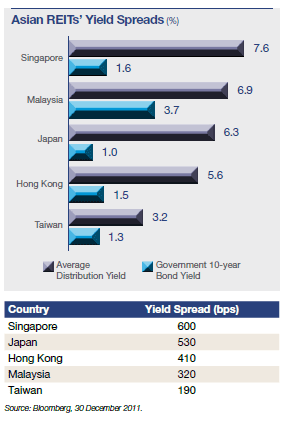Singapore REIT Sector
S-REITs' High Yield Spreads
Singapore real estate investment trusts (S-REITs) continued their post-global financial crisis recovery in the first seven months of 2011. However, when global markets turned a corner in August, the S-REIT sector eased in tandem with the broad market, on the back of heightened risk aversions. The higher beta office and hospitality REITs saw their unit prices falling sharply, as the economic outlook appeared more uncertain. The FTSE ST REIT Index closed down by 16.0% compared to the beginning of the year, marginally outperforming the Straits Times Index by 1.0 percentage point.
Two S-REITs made their debut in 2011, bringing the number of S-REITs to 27. As at end-2011, the total market capitalisation of S-REITs registered S$36.1 billion, down by 3.0% from S$37.2 billion in the previous year. The average distribution yield of S-REITs expanded to 7.6% as at 30 December 2011 from 5.7% as at 31 December 2010. This was approximately 600 basis points (bps) above the Singapore government 10-year bond yield of 1.6% as at 30 December 2011. Compared to other Asian REITs, S-REITs' yield spreads were the highest.
Several S-REITs took advantage of the low interest rate and ample liquidity environment to take on higher debt levels or raise equity to fund acquisitions. Since the start of 2011, S-REITs have completed close to S$5.2 billion worth of property acquisitions.
In 2011, some of the larger REITs by market capitalisation ventured into greenfield development to tap on this new growth avenue. S-REITs are bound by regulations to limit development activities to a maximum of 10.0% of total deposited property. These development projects are expected to yield higher returns, compared to yields that can be reaped from acquisitions of completed properties. The success of such greenfield projects are also subjected to higher leasing risks which can be mitigated for those REITs which have an extensive network of potential tenants to leverage on.
S-REITs have generally been more conservative in the past two years and have lower refinancing risks, given their stronger balance sheets. They have reduced their gearing levels, diversified their funding sources, extended their debt maturities and unencumbered a larger proportion of assets. Given the benign interest rate environment in 2011, many S-REITs have also taken the opportunity to lower their average funding cost.

In November 2011, the Monetary Authority of Singapore (MAS) announced that it will consider issuing further regulatory guidance to the S-REIT industry in order to boost corporate governance standards. While not highlighting specific companies, MAS made the announcement in response to criticism that current rules governing the REIT sector are inadequate to protect the interests of minority unitholders.
However, MAS acknowledged that corporate governance rules and guidelines cannot envisage all circumstances and the regulator urged all S-REITs to uphold high standards of corporate governance.
Looking Forward
S-REITs today are better positioned to weather a potential economic crisis, compared to the global financial crisis (GFC) in 2008/2009, given more conservative asset values, stronger balance sheets and lower refinancing risks. Many market watchers believe they are unlikely to suffer from similar levels of decline in asset valuations last seen in the GFC. Concerns on refinancing risks and earnings defensiveness are likely to take centre stage for S-REITs in 2012.
